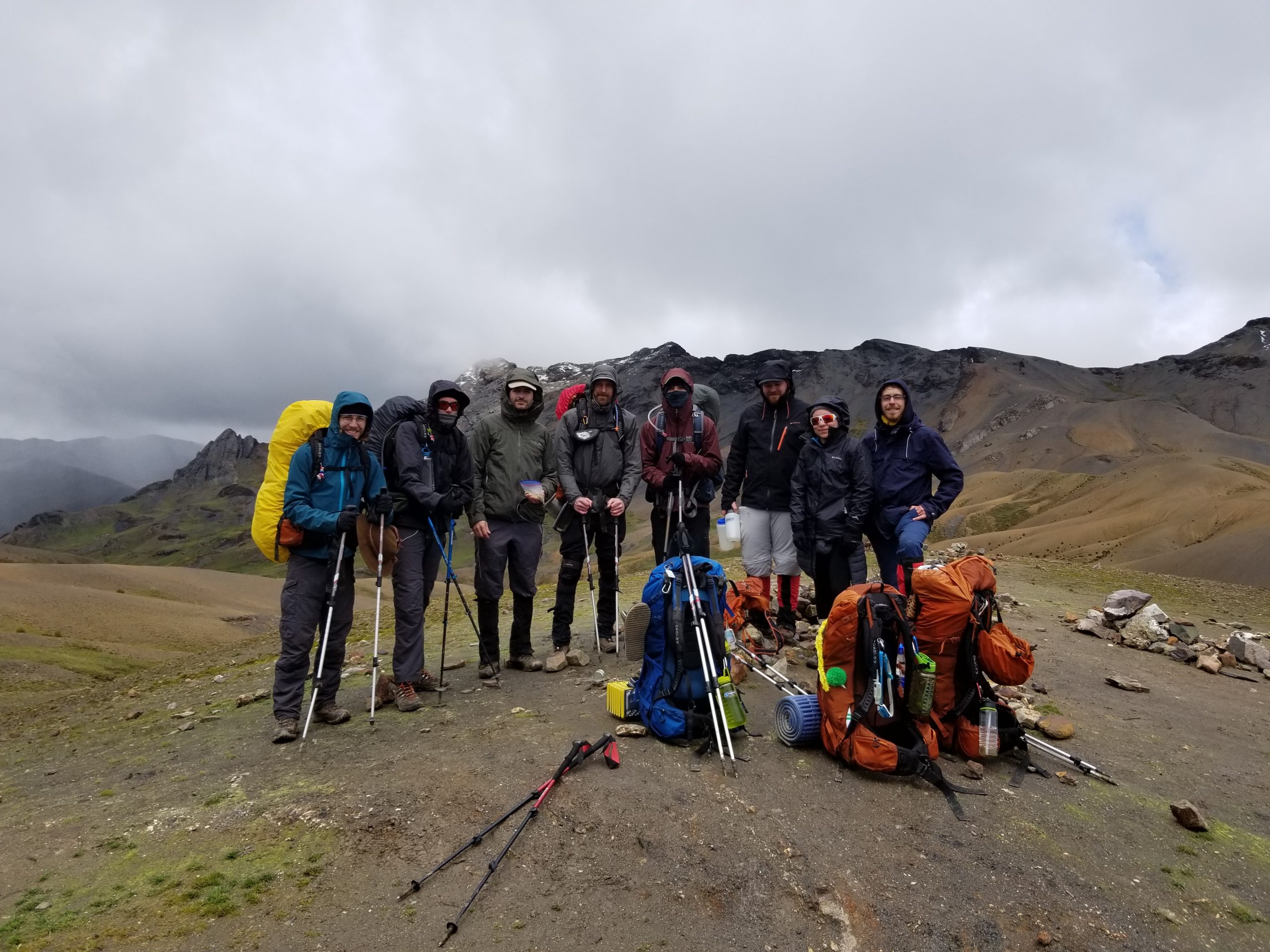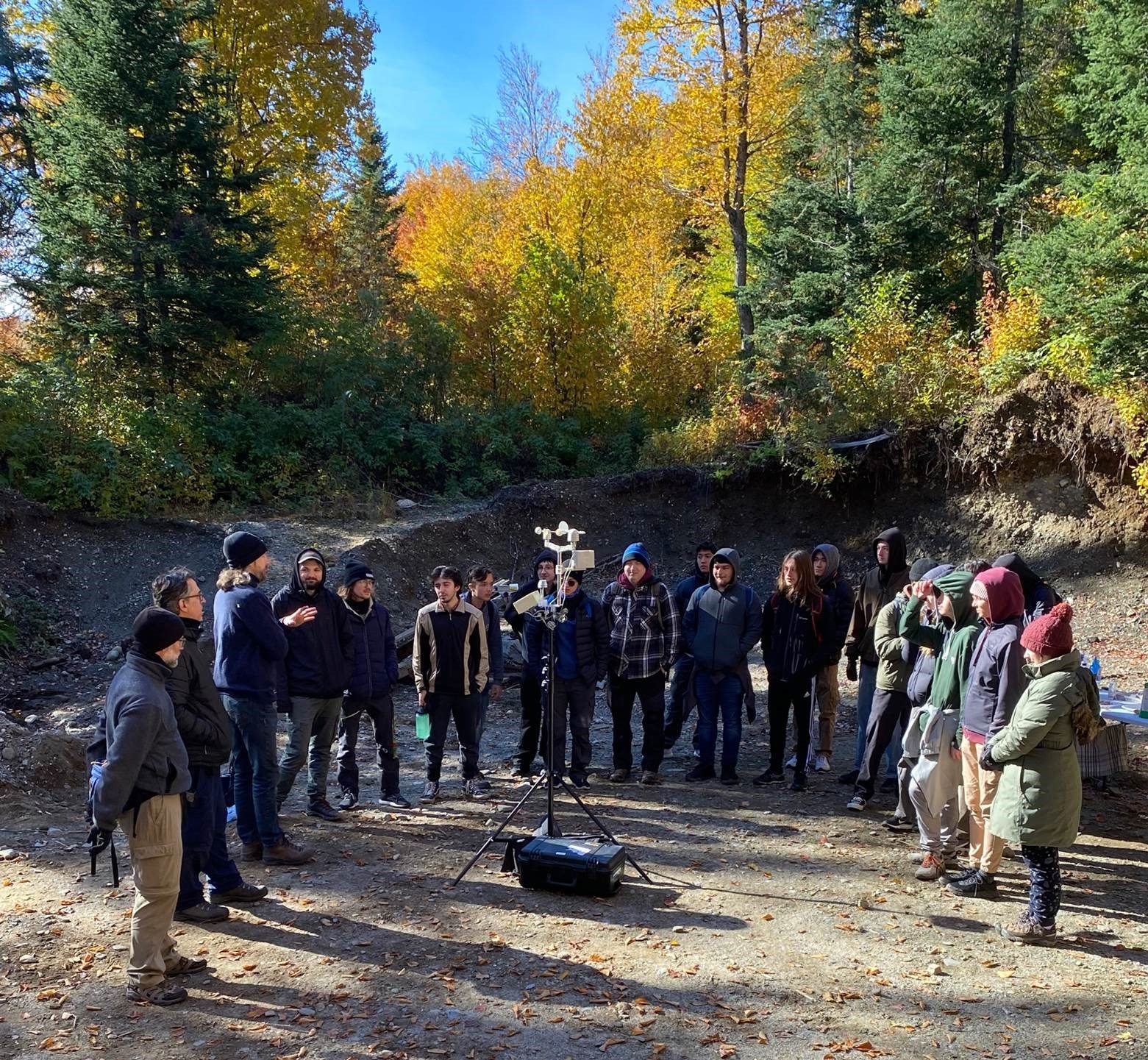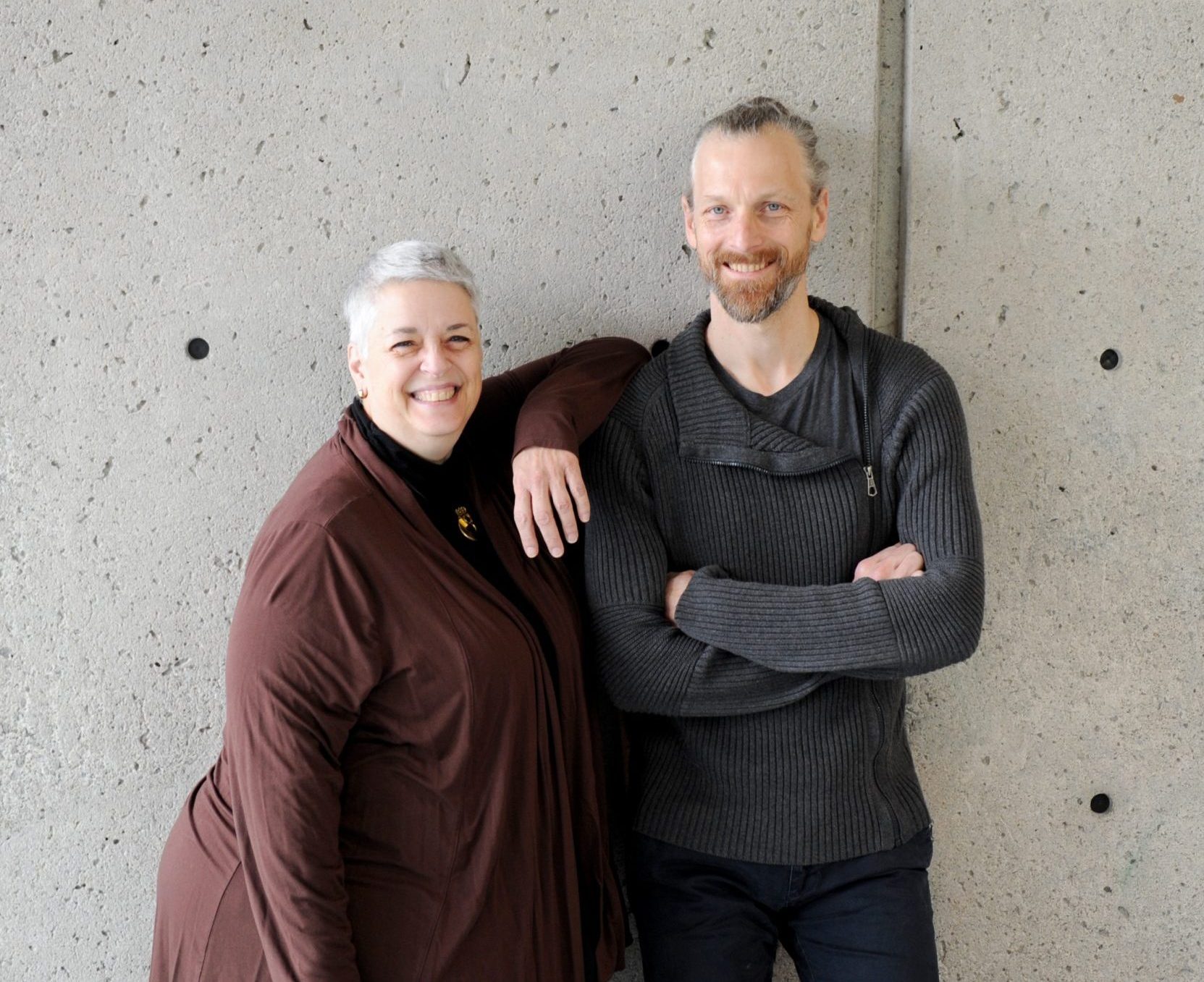
The complete group, during the trip to Peru in 2019-2020
In fact, in the current project, graduating volunteers act as mentors for younger students. These students did not have the opportunity to experience the kind of activities that David and Julie are currently deploying when they entered the program, but they have valuable skills and are familiar with David’s weather station project.
In the context of the new research projects, student involvement will be systematized, broader and more consistent. The research will observe and document the impacts on students of their participation in such projects.
Activities integrated into courses
At the time I spoke with David and Julie, the 1st session of the project was coming to an end. The Engineering Physics Technology teachers had identified 2 1st-session courses in which pedagogical activities had been replaced with activities related to the weather station project.
Geocaching at Angrignon Park
In one of the classes, to familiarize themselves with GPS positioning (essential for the operation of a portable weather station), the students did a geocaching activity at Angrignon Park. This park is adjacent to the college. The students spent 90 minutes in the park taking measurements. They learned how to read a map and how to read GPS coordinates. At each coordinate point they reached, they had to take a series of measurements using their portable weather station.
As David explained to me, when you are going to install a weather station on a glacier, you have to know how to use a GPS. If only to be able to go back to the right place to recover the station afterward!
Julie told me that the students (and teachers!) loved the experience. Several students mentioned that they enjoyed just being outside. This reminded me of the virtues of outdoor pedagogy, which is becoming more and more popular.
Learning how to use software that will be part of the project
In another class, students learned how to use a software program that allows analyzing the data they had taken with their weather station during the Angrignon Park activity.
Activities outside of courses
The activities integrated into the courses are mandatory for all. However, the project also includes non-mandatory (but popular!) extracurricular activities. These activities also draw on the students’ engineering skills.
Program welcome activity
In the fall of 2022, the 1st-year students, accompanied by several teachers (including David and Julie) and 5 3rd-year student mentors, went on a field trip to the Mont-Mégantic Observatory. (The Observatory is a partner in the research project.) The Observatory has weather instruments on site at the top of the mountain. The teaching team and mentors invited the 1st-year students to come with them to observe their work during a simulated expedition. 95% of the 1st-year students participated.

Students listen to explanations about the operation of the weather station during the field trip to Mont Mégantic.
The field trip to Mont-Mégantic served as a program welcome activity. This activity was an opportunity for the new students to discover other professional perspectives for engineering technologists than those they usually know about when they enroll in the program. Many see themselves working in a laboratory, but engineering physics can take them to many different places!
Most importantly, the activity had an important social aspect. It allowed the students to develop a sense of belonging to their group and to bond with the teaching team.
During the activity, 1 1st-year teacher was present, but also 3 2nd-year and 3rd-year teachers. For the students, seeing that their future teachers are there is very motivating! They see that there is an overall unity in the program, that the program will not be a bunch of disjointed courses.
-David Beaulieu
Conference by a meteorologist
One afternoon in late November 2022, meteorologist Gilles Brien came to meet with the Engineering Physics Technology students to talk about climate change. His scientific explanations made the students aware that these changes will affect many places on Earth differently.
Paid student work
Starting in their 3rd session, students will be able to get involved in the project outside of class hours to act as research assistants on a voluntary basis.
Becoming familiar with the project, gradually
In their 1st session, students do not have the skills to participate in the design of the station. However, they can already learn how to use the station and, more generally, learn about taking measurements in the field. They learn about the project from their teachers and student mentors. Seeing the last-year students at work allows them to understand the concrete usefulness of the knowledge they are acquiring in their courses. As David told me, it shows them how difficult concepts taught in their math classes can be useful.
We involve 1st-year students in a project to measure environmental data related to climate change. This is a social issue that concerns them.
-David Beaulieu
As they gain skills throughout their academic careers, students who are now in their 1st year will be able to contribute to the design project in increasingly meaningful ways, either in their courses or on a voluntary basis extracurricularly.
A graduation trip
During their final year of study, graduating students who wish to do so will be able to take a trip to set up their station on a glacier to test it and collect data. (The station tested in Peru in 2019-2020 could not be left behind. The goal now is to design a station that could operate autonomously on a glacier).
What is the purpose of the data collected by the weather station?
The objective is that the data collected will be used by the GlacioLab [in French] of the Université du Québec à Trois-Rivières (a partner in the project). The GlacioLab is directed by Christophe Kinnard [in French], who is also the Director of the Canada Research Chair in Cryospheric Hydrology.
The GlacioLab studies glaciers, but data is very sparse or non-existent for some (such as the Peruvian glacier visited by David and his students in 2019-2020).
The engineering technologists from Cégep-André Laurendeau could thus use their expertise in design and measurement to provide data to the GlacioLab team. Christophe Kinnard and his team will then use this data to feed a predictive model on glacier melting. This is no small feat!
Other partners in the project include the Centre d’études nordiques de l’Université Laval [in French] (CEN). The CEN provides David and his team with access to a network of weather stations across the Canadian Arctic, as well as access to their remote research stations. The Cégep André-Laurendeau team can use the data provided by the CEN to calibrate their own.
Hypotheses about the winning conditions for the pedagogical use of wicked problems in authentic situations
According to David and Julie, for the pedagogical use of a wicked problem in an authentic situation to be successful, the problem must be one that the students care about.
Authenticity is not necessarily enough. David explained to me that he could have taken his students to a screwdriver factory and asked them to design a sensor to detect faulty screwdrivers. That would have been very pedagogically relevant and authentic, but finding an issue that the students care about and are genuinely interested in makes the activity even more powerful.
We are not going to solve the problem of climate change, but we are going to participate in finding solutions. We contribute to finding solutions with our own expertise: taking measurement.
-David Beaulieu
Thus, the strength of a “good” wicked problem is that it goes beyond the students’ academic interests and career aspirations and genuinely touches them.
The key is that in the worst moments of their studies, when students don’t know why they are in Engineering Physics Technology, the project will remind them that they are working for a cause bigger than themselves. That will motivate them!
-David Beaulieu
Julie agrees: the choice of the problem is central. Climate change, world hunger… These are problems for which finding a solution will be motivating. Obviously, it is important to identify a portion of the problem that we want to tackle with our students. By definition, wicked problems are “larger than life” problems. Climate change and world hunger are not problems that students can really solve… You have to choose a specific aspect of the problem, such as measuring glacier melt in the case of David and Julie’s project.
On the other hand, David believes that in order for the pedagogical use of a wicked problem to be successful, it is very important to work concretely on solving the problem. It’s not enough to run a simulation in class and say, “This is what we could do.” You have to act for real. It’s not enough to study an authentic problem; the contribution you offer to its solution must be authentic as well.
Julie also told me about the value she sees in having their project span the entire program and be thought of in a program-based approach. However, in another context, a teacher might still choose to use a wicked problem in an authentic situation on a smaller scale, integrating it into a single course.
Of course, research will reveal much more (or correct misperceptions!) about the educational use of wicked problems!






